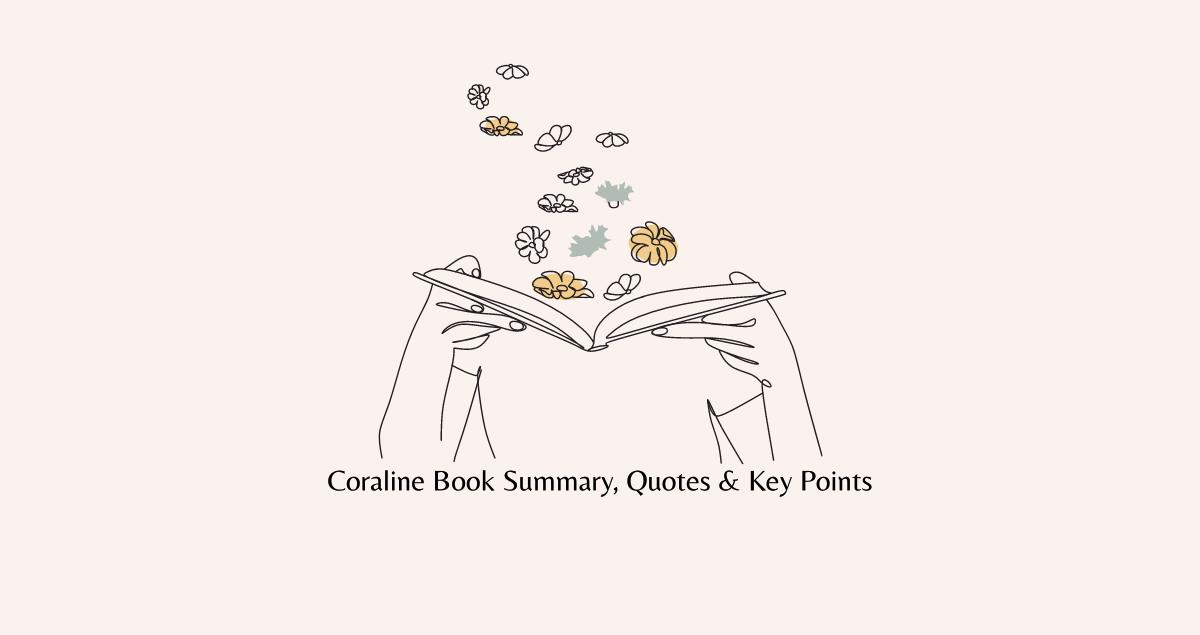Coraline is a dark fantasy novel written by Neil Gaiman that tells the story of a young girl who discovers a parallel world that seems like a better version of her own reality, but soon realizes that it is a trap set by a sinister entity. In this book summary, we will explore the main plot, themes, symbolism, writing style, and critical reception of Coraline, as well as provide a review, key points, and FAQs about the book.
Table of Content
Coraline Book Summary
Plot Summary
Coraline Jones is an adventurous and curious girl who moves with her parents to a new apartment in an old house that has been divided into flats. She feels neglected by her busy parents, who are too absorbed in their work to pay much attention to her. One day, while exploring the house, Coraline discovers a small door that leads to a dark and eerie corridor. When she opens the door, she finds herself in a parallel world that looks like her own, but with some twisted differences. In this other world, Coraline meets her Other Mother and Other Father, who are more attentive and fun than her real parents, and a group of talking animals and toys. However, Coraline soon realizes that the Other Mother is not what she seems, and that she wants to keep Coraline trapped in the parallel world forever. With the help of a mysterious cat and her own wit and courage, Coraline must find a way to escape the Other Mother's clutches and return to her real world.
Themes
Coraline explores several themes, such as bravery, identity, and family. The book shows how Coraline's bravery and resourcefulness are tested in the face of danger and fear, and how she learns to rely on her own strength and intelligence to overcome obstacles. The book also deals with the theme of identity, as Coraline struggles to find her place in the world and to define herself beyond her parents' expectations. Finally, the book portrays the importance of family, both in terms of its positive and negative aspects, as Coraline learns to appreciate her real parents' love and care, while also confronting the dark side of family relationships.
Symbolism
Coraline makes use of several symbols to convey its themes and messages. The key, for example, represents Coraline's agency and power, as she uses it to unlock doors and to escape from the Other Mother's grasp. The button eyes, on the other hand, symbolize the loss of identity and free will, as the Other Mother replaces her victims' eyes with buttons to control them. Finally, the parallel world itself is a symbol of the dangers of escapism and the allure of a perfect, but false, reality.
Writing Style
Neil Gaiman's writing style in Coraline is dark, whimsical, and suspenseful. He uses vivid and imaginative language to create a creepy and unsettling atmosphere, as well as to bring to life the fantastical creatures and settings of the book. The tone of the book is both humorous and eerie, as Gaiman balances the light and dark elements of the story with skill. The point of view of the book is third-person limited, which allows the reader to see the world through Coraline's eyes and to experience her emotions and thoughts.
Reception
Coraline has received critical acclaim since its publication in 2002, and has won several awards, including the Hugo Award for Best Novella, the Nebula Award for Best Novella, and the Bram Stoker Award for Best Work for Young Readers. The book has been praised for its imaginative and original story, its vivid and engaging characters, and its skillful use of horror and fantasy elements to explore deeper themes.
Coraline Book Review
Plot Review
Coraline's plot is well-crafted and engaging, with a good balance of suspense, humor, and emotion. The pacing of the story is fast and tense, with enough twists and turns to keep the reader on edge. The structure of the story is also effective, as it gradually builds up the tension and the stakes, and leads to a satisfying resolution. Overall, the plot of Coraline is a strong and memorable aspect of the book.
Character Review
The characters in Coraline are well-drawn and memorable, with distinct personalities and motivations. Coraline herself is a likable and relatable protagonist, who grows and develops throughout the story. The Other Mother is a chilling and fascinating villain, who embodies the dangers of false promises and manipulation. The supporting characters, such as the cat, the neighbors, and the toys, are also interesting and quirky, and add depth and humor to the story. Overall, the characters in Coraline are a strong and memorable aspect of the book.
Writing Style Review
Neil Gaiman's writing style in Coraline is a unique and effective blend of horror, fantasy, and humor. His use of language is vivid and imaginative, and his descriptions of the settings and creatures are both creepy and enchanting. The tone of the book is both eerie and whimsical, and Gaiman balances the light and dark elements of the story with skill. However, some readers may find the writing style too dark or disturbing for their taste.
Overall Review
Coraline is a dark and imaginative book that combines horror, fantasy, and humor to create a memorable and engaging story. The book's themes of bravery, identity, and family are explored with depth and nuance, and the use of symbolism adds richness and depth to the story. The characters are well-drawn and memorable, and the writing style is both vivid and effective. However, some readers may find the book too dark or disturbing for their taste, and the target audience may be limited to older children and young adults.
Coraline Quotes
"Fairy tales are more than true: not because they tell us that dragons exist, but because they tell us that dragons can be beaten."
"Because,' she said, 'when you're scared but you still do it anyway, that's brave."
Coraline Key Points
Parallel World
The parallel world in Coraline is a twisted and dangerous version of the real world, where everything seems perfect, but is actually a trap set by the Other Mother. The parallel world is a symbol of the dangers of escapism and the allure of a perfect, but false, reality.
Button Eyes
The button eyes in Coraline represent the loss of identity and free will, as the Other Mother replaces her victims' eyes with buttons to control them. The button eyes are a chilling and memorable symbol of the Other Mother's power and manipulation.
Bravery
The theme of bravery is central to Coraline, as Coraline learns to face her fears and to rely on her own strength and intelligence to overcome obstacles. The book shows how bravery is not the absence of fear, but the ability to act in spite of it.
FAQs for Coraline
1. What is the significance of the key in the book?
The key in Coraline represents Coraline's agency and power, as she uses it to unlock doors and to escape from the Other Mother's grasp. The key is a symbol of Coraline's ability to take control of her own fate.
2. How does Coraline's relationship with her parents change throughout the story?
Coraline's relationship with her parents starts off distant and strained, as they are too busy with their work to pay much attention to her. However, as Coraline goes through her ordeal in the parallel world, she learns to appreciate her real parents' love and care, and to see them in a new light.
3. What is the Other Mother's motivation for wanting Coraline to stay in the parallel world?
The Other Mother's motivation for wanting Coraline to stay in the parallel world is to use her as a replacement for her lost daughter, who escaped from her grasp. The Other Mother is a manipulative and possessive entity who craves love and attention, but is incapable of giving it genuinely.
4. How does the theme of identity play out in the book?
The theme of identity in Coraline is explored through Coraline's struggle to define herself beyond her parents' expectations and to find her place in the world. Coraline's journey in the parallel world challenges her sense of self and forces her to confront her fears and desires.
5. What is the role of the cat in the story?
The cat in Coraline is a mysterious and enigmatic character who acts as a guide and a protector for Coraline. The cat is a symbol of independence and wisdom, and helps Coraline to navigate the dangers of the parallel world and to find her way back home.
6. How does the book address the concept of fear?
The book addresses the concept of fear by showing how Coraline learns to face her fears and to overcome them through bravery and resourcefulness. The book also portrays the dangers of giving in to fear and of being controlled by it, as seen in the fate of the Other Mother's victims.
7. What is the significance of the snow globe in the book?
The snow globe in Coraline is a symbol of the parallel world and of the Other Mother's power. The snow globe contains a miniature version of the parallel world, and is used by the Other Mother to lure Coraline into her trap.
8. How does the book use humor to balance out the darker elements?
The book uses humor to balance out the darker elements by adding lightness and levity to the story. The humor comes from the quirky and eccentric characters, such as the neighbors and the toys, and from the witty and irreverent dialogue.
9. How does the book compare to the movie adaptation?
The movie adaptation of Coraline is faithful to the book in terms of plot and characters, but adds some new elements and changes some details. The movie is visually stunning and captures the eerie and whimsical atmosphere of the book, but some fans may prefer the darker and more nuanced tone of the book.
10. What age group is the book best suited for?
The book is best suited for older children and young adults, as it contains some dark and disturbing elements that may not be suitable for younger readers. However, the book's themes of bravery, identity, and family are universal and can be appreciated by readers of all ages.

